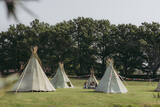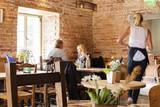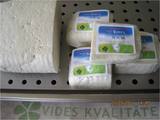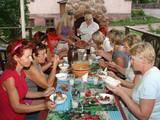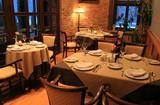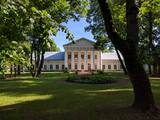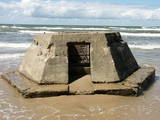| Нo | Название | Описание |
|---|---|---|
|
Герцог Екаб (Jēkabs) правил в Курземе и Земгале с 1642 по 1682 год. В те времена стремительно развивалось кораблестроение, появились первые мануфактуры и увеличились объемы сельскохозяйственного производства. Корабли экспортировали товары в Европу, отправлялись на Тобаго и в Гамбию, моряки основывали там колонии и везли в Европу сахар, кофе и приправы. В тот период в Латвии появился картофель, полюбившийся местным жителям лишь пару столетий спустя. Курземский деликатес – угри из озера Усмас: из них варят супы, их жарят и коптят; в сезон готовят также саргана, корюшку и салаку, а килька, сельдь и лосось доступны круглый год. Здесь пекут ржаной хлеб, кисло-сладкий хлеб или скландраусисы, варят ячневую кашу с простоквашей или букстиньпутру. Суйтские женщины предлагают научиться готовить традиционные блюда. К летнему солнцевороту во многих местах готовят Янов сыр, в обычные дни предлагаются и другие вкусные сыры из коровьего и козьего молока. Популярны также блюда из мяса домашнего скота и птицы, их готовят в том числе в глиняных горшочках вместе с кореньями. На гарнир подают тыкву, овощи, коренья, грибы, бобы или перловку с невероятно вкусными соусами. В сезонном предложении трактиров можно найти дичь: оленину, зайчатину, мясо косули и бобра. Гурманов ждут пироги, медовый торт и булочки с маком, которые в Кулдиге пекут по средневековым рецептам. На сладкое – черничные клецки или бигузис из ржаного хлеба с медом, брусникой или клюквой и сливками. Жажду можно утолить душистыми травяными чаями и медом. Головокружительные впечатления вы сможете получить во время дегустации домашних вин, за кружкой вкусного пива или стаканчиком более крепкого напитка. |
||
|
The “backbone” to this park is the valley of the Šventoji (Holy) River. One of the most impressive Devonian cliffs in Lithuania can be seen from the river – Vetygalos atodanga. On the shores of the Varius stream is a cliff made of quartz and sand – Variaus atodanga. 6 km to the S of Anykščiai is Lithuania’s second largest rock (5.7 m high, ~100 m3) – Puntukas akmuo.
|
||
|
A beautiful part of the Rēzekne-Dagda-Krāslava road – along two km or so, you can see Lake Rāzna and Mākoņkalns hill, which is 10 km away on the other shore of the lake. |
||
|
Glamping "Kadiķi" is located in Auce region - it will open in July 2021. It is a unique recreation area with a private area where you can find new feelings, spend the night in wigwam, merge with nature, enjoy the peace and quiet far from the city, see flocks of deer and deer, surround the surrounding waters, go hiking on forest trails, archery, enjoy the beauty of the natural landscape and gain an unforgettable rural adventure. The company's values are nature, private space and atmosphere, ecologically responsible attitude towards the environment. The wigwam has amenities worthy of a glamping tent - bed, interior items, outdoor terrace. Guests will also have breakfast. Nomadic Homes also offers to buy or rent wigwams for private events, recreation or starting your own business. |
||
|
Traditionelle Spielzeuge von verschiedenen historischen Perioden und Völkern. |
||
|
Ungru Resto ir piejūras restorāns Hījumā ziemeļu krastā, kur atmosfēru rada kādreizējā muitas māja, Suursadamas vide, kvalitātīvs ēdiens un apkalpošana. Ēdienkartē tiek izmantotas vietējie produkti un tiek gatavoti tradicionālie Hījumā salas ēdieni, pasniegti mūsdienīgā stilā. Restorāns Ungru Resto - iesaka White Guide 2018. |
||
|
This tour includes a walk along the Baltic Sea coast Lithuania through the Curonian Spit from Nida to Smiltynė (see a detailed description under tour No. 9) and continues further north from Klaipėda to Šventoji located at the Lithuanian/Latvian border. Klaipėda and Palanga are popular seaside resorts with lots of pubs, hotels, street cafés and musicians. Klaipėda is the only port city and the third largest city in Lithuania. Šventoji is also a popular seaside town located next to the mouth of the river Šventoji. Between Klaipėda and Palanga, the Baltic Coastal Hiking Route leads through the Seaside Regional Park (Lithuanian: Pajūrio regioninis parkas). It was founded for the protection of coastal and marine landscapes, biodiversity and local cultural heritage. The most famous place of the seaside is the Dutch Hat (also called Dutch Cap, Dutchman’s Cap or Holland’s Cap) – a 20 m high cliff, which used to serve as a landmark and guide for seafarers and fishermen. |
||
|
Atrodas Tirdzniecības kanāla dienvidu krastā, kas padomju laikā bija slēgta zona ar pierobežas režīma statusu. Tagad lieliska pastaigu vieta, kur var vērot kuģīšus un jahtas. Promenādes visā garumā izvietojušies vēsturiskie spīķeri. Šeit meklējami krodziņi, viesnīcas, mūzikas klubs, mākslas galerija un Dzintara pulkstenis. |
||
|
В сумеречном погребе господской усадьбы можно послушать рассказ об искусстве приготовления домашнего вина и попробовать вино из ревеня, черной смородины и клубники вместе с сельскими дарами, произведенными в окрестностях (сыр и др.). Вино изготавливается при использовании продукции, произведенной местными крестьянами. |
||
|
Предлагают экскурсию по хозяйству, где можно увидеть коз, лошадей, кроликов, птиц и домашних животных. Интересующиеся могут записаться на сеансы рейттерапии, покататься верхом на лошади, пони и в подводе. Приобретение продукции козоводства – молока, сыра, творога, кефира и йогурта. |
||
|
Alūksnes novada saimniecībā "Pauguri" kokamatnieks Jānis Vīksne izgatavo koka virpojumus - cibiņas, pulksteņus, pildspalvas, spēles, šūpoles un citas saimniecībā noderīgas lietas. Iespējams iegādāties kokamatniecības suvenīrus - dekoratīvus un praktiskus virpojumus no koka. Senlietu muzeja apskate - seni galdniecības darba galdi, ēveles, āmuri, sirpji, grābekļi, sējmašīna, pulksteņi, trauki u.c. Saimniecībā ir izveidota skatu platforma, no kuras paveras skats uz Hānjas augstienes ainavām Igaunijā, kā arī atpūtas vieta vasaras piknikam ar galdu, uguskura vietu un skulptūrām. |
||
|
Корчма находится в центре столицы суитов Алсунге. Суиты всегда любили хорошо поработать, хорошо спеть и хорошо поесть! Хозяйки «Спелманю крогса» предлагают группам отведать приготовленные по старинным рецептам древних суитов блюда, а также всем вместе освоить приготовление скландраушей, клецок, скабпутры и других блюд этой стороны. Трапезу сделает незабываемой эффектное выступление женщин-суитов. Можете купить скландрауши и кислый хлеб, который пекут только у нас. Латышская кухня: Кисло-сладкий хлеб, клёцки, копченые рёбрышки. Особое блюдо: Домашние скландрауши. |
||
|
В историческом центре Гулбене ‒ в восстановленном здании конского манежа усадьбы Вецгулбене, который раньше являлся крупнейшим крытым манежем в странах Балтии, ‒расположена четырехзвездочная гостиница и ресторан. Посетителям предлагается обширное сезонное меню и бизнес-ланчи. Латышская кухня: Холодный летний суп, стейк из бедра барашка, маринованная нога кролика, жареная голень утки, клубничный суп с мороженым. |
||
|
Atrodas Rīgas ielā 8 – skaistā, 1883. g. celtā jūgendstila ēkā . Muzejs (viens no Latgales lielākajiem un vecākajiem) tajā darbojas no 1959. g. (pats muzejs dibināts 1938. g.) un tā krājums vēsta par Daugavpils un tās apkārtnes vēsturiskajiem notikumiem. Tajā regulāri tiek rīkotas arī tematiskās izstādes, piedāvātas muzejpedagoģiskas programmas. Te vēl var apskatīt Daugavpilī dzimušā un pasaulē pazīstamā mākslinieka Marka Rotko (1903. – 1970.) gleznu reprodukcijas, kuras no 2013. gada plānots pārcelt uz M. Rotko centru Daugavpils cietoksnī. |
||
|
Takas sākums atrodas Vidagā, vietā, kur uz Vizlas celts vēsturiskais akmens arkas tilts. 1,2 km garā taka bez marķējuma ved gar pašu upes krastu līdz pat ietekai Gaujā. Redzami skaisti dolomīta atsegumi, nelieli krāčveidīgi ūdenskritumi un iespaidīgais Žākļu dižakmens. |
||
|
Усадьба Салос и ее парк расположены на острове озера Двирагис, чьи контуры с высоты птичьего полета напоминают силуэт Литвы на географической карте. В восточной части усадьбы находится парк смешанной планировки. Это один из старейших парков в Литве. Еще во времена хозяйствования Радзивиллов здесь был лесопарк с запретом на вырубку деревьев. В парке преобладали лиственные деревья местных пород: клены, липы, ясени, тополя сереющие, которым сейчас сравнялось двести лет. По берегу озера проходила тропа, соединявшая аллею с парковой дорожкой. Сегодня здесь сохранились зеленые насаждения, фрагменты аллей. |
||
|
This tour is suitable only for experienced hikers. The itinerary circles the Suurupi Peninsula where the dense forests conceal the military heritage of different eras. The Baltic Coastal Hiking Route meanders through overgrown and rocky seacoasts, birch groves, along former pioneer camps and sand-stone cliffs protecting coves with sharp capes. At the end of the itinerary, one of the most astounding outcrops of the Estonian littoral rises before your eyes – the Rannamõisa Cliffs, which gives views of Kakumäe Bay and Peninsula and the towers of Tallinn’s Old Town |
||
|
От батареи до наших дней сохранились остатки железобетонного дзота, которые в результате длительного воздействия ветра и волн, омывавших берег, сползли до самого пляжа. Вызывающий интерес исторический памятник, чья судьба на протяжении длительного времени была предсказуема, – скрылся ниже уровня моря.
|
||
|
Усадьба Брукнас является неожиданным сюрпризом в этом месте и в это время. Строительство здания поместья началось в середине 18-го века, а столетие спустя – перестроено. В первой половине 20-го века в здании усадьбы была размещена начальная школа, а в советское время - обустроены квартиры. Сейчас здание усадьбы возродилось в новом качестве - как по форме, так и по содержанию - как в прямом, так и в переносном смысле. Здесь действует общественная организация "Сообщество горных благословений", летом проводятся детские и молодежные лагеря и другие мероприятия. Внутри здания сохранилась старая деревянная резная лестница, оконные ставни и латунные дверные петли. Возводится церковь. Можно осмотреть сад из культурных растений в стиле ренессанс. По предварительной записи, здание усадьбы, а также церковь, построенную местными обитателями, можно осмортеть также изнутри, в сопровождении обитатетелей усадьбы, которые расскажут также об истории и событиях усадьбы и сада. В 300 метрах к юго-западу от усадьбы находится городище Брукны, однако его трудно распознать и еще труднее до него добраться. |
||
|
The restricted area protects the seashore meadows of the Lielupe River estuary, which are a very uncommon habitat in Latvia. The restricted area is on the left bank of the river, where one of the largest areas of wild swamp angelica is found. This is an important nesting area for birds. The territory is not improved for tourism, and it should be viewed from the Baltā (White) dune that is on the opposite bank of the Lielupe River. From there, the visitor will see a lovely landscape featuring the river estuary and the meadows which are around it.
|
||




